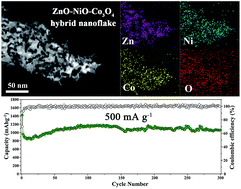Design and synthesis of ZnO–NiO–Co3O4 hybrid nanoflakes as high-performance anode materials for Li-ion batteries†
Abstract
ZnO–NiO–Co3O4 hybrid nanoflakes are fabricated via a simple hydrothermal method followed by a subsequent annealing process. In these hybrid electrode materials, ZnO and NiO are the main active materials while a small amount of Co3O4 is introduced as a catalyzing and performance-enhancing agent. The obtained hybrid materials possess a novel 2D nanoflake structure which is mainly constructed by firmly interconnected ZnO and NiO nanoparticles. The particle size of ZnO and NiO is reduced to about 47 nm and 12 nm, respectively, through the hybridization process. When applied as anode materials, the ZnO–NiO–Co3O4 hybrid nanoflakes exhibit a high reversible capacity of 1060 mA h g−1 after 300 cycles at 500 mA g−1. The successful alleviation of the capacity fading problem and excellent electrochemical performance can be ascribed to the unique 2D nano-morphology, strong cobalt catalysis, improved electronic conductivity, uniform dispersity and porous surface. The results demonstrate that the ZnO–NiO–Co3O4 hybrid nanoflakes are promising anode materials for high-performance lithium-ion batteries.


 Please wait while we load your content...
Please wait while we load your content...